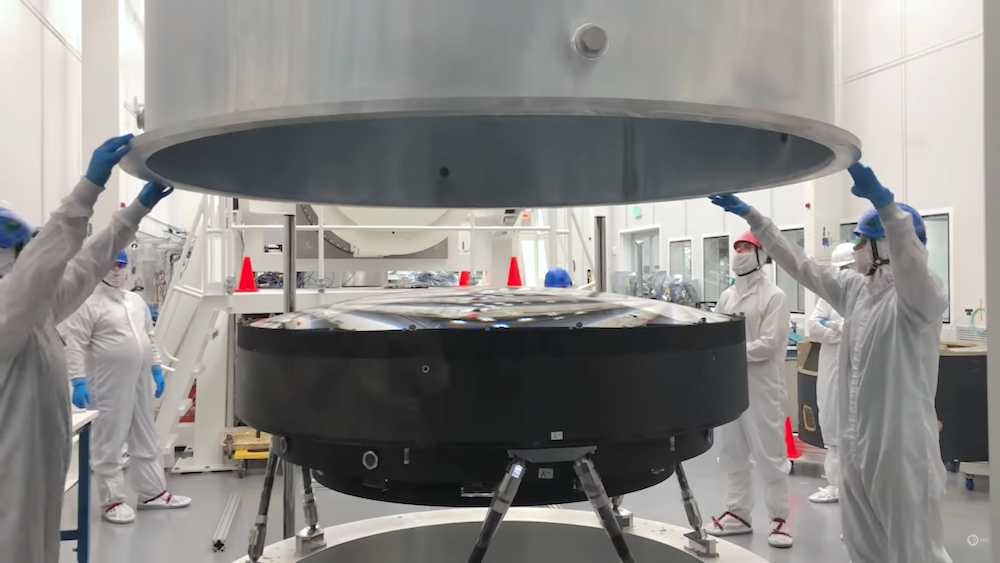
[Image above] NASA is not the only government agency in charge of telescopes. The Large Synoptic Survey Telescope, funded through the National Science Foundation, will contain both the largest convex mirror and largest optical lens ever made. Credit: Physics Girl, YouTube
If you follow fiscal negotiations for United States federal science budgets, you’ve probably witnessed the contention concerning funding for NASA’s James Webb Space Telescope (JWST), the top-ranked large space mission of the 2000 Astronomy and Astrophysics Decadal Survey.
Originally targeted to launch in 2014 at a 2009 baseline estimate of about $5 billion, JWST’s estimated lifecycle cost doubled to nearly $10 billion and is now targeted to launch in 2021. These troubles have delayed work on the Wide Field Infrared Survey Telescope (WFIRST), the top-ranked large space mission of the 2010 decadal survey.
With a lot of political reporting focusing on the battle between the White House and Congress over discontinuing or funding WFIRST, other planned telescopes may escape the public eye—such as the Large Synoptic Survey Telescope (LSST) funded through the National Science Foundation.
Like WFIRST, LSST was recommended as a top priority in the 2010 decadal survey. While WFIRST will survey galaxies from space, LSST will perform large-scale, ground-based research initiatives.
LSST is currently under construction in Chile, and both the House and Senate FY20 budget proposals match NSF’s requested amount of $46 million to continue construction.
LSST will be able to image the entire visible southern sky every few nights by using a 3.2-gigapixel camera and some massive optics to capture a 15-second exposure of the night sky every 20 seconds. And when I say “massive” optics, I’m not exaggerating—this giant digital camera will contain both the largest convex mirror and largest optical lens ever made!
The mirror
“The LSST telescope consists of three aspheric (nonspherical) mirrors: an 8.4-m primary mirror, a 3.5-m convex secondary mirror, and a 5.0-m tertiary mirror,” the LSST website explains. “The primary and tertiary mirrors were fabricated from a single piece of Ohara E6 low-expansion glass, resulting in the monolithic LSST Primary/Tertiary Mirror (M1M3). The LSST Secondary Mirror (M2) is the largest convex mirror ever made.”
In the camera, the M2 mirror is supported above and facing the M1M3 monolith, and a system of actuators is used to maintain alignment of the three mirror surfaces. Because of this configuration, weight is a concern for the M2 mirror assembly. “[W]ithout modification, the solid glass mirror and assembly would weigh 11,450 lbs (5205 kg),” the LSST website explains. To reduce weight, scientists removed 1,735 lbs of glass from the back, leaving a ribbed structure behind a 19-mm sheet of glass as the mirror’s face.
The lens
In addition to the mirrors, LSST contains three large fused-silica lenses and a filter. “The largest lens (L1) is 1.55 m in diameter, half again as large as the 40-inch Yerkes refractor—the world’s biggest astronomical refracting telescope,” the LSST website explains. “The 0.69 m third lens (L3) also serves as the vacuum barrier for the focal plane array (FPA) cryostat and requires a center thickness of 60 mm.”
A press release by Lawrence Livermore National Laboratory states the L1 lens “is believed to be the world’s largest high-performance optical lens ever fabricated.”

In September 2019, the lens assembly was mounted in a carbon fiber structure and shipped from Tucson, Arizona, to the SLAC National Accelerator Laboratory in California. Upon arrival, the assembly was inspected to ensure it made the trip safely, and during that process Dianna Cowern, host of the Physics Girl YouTube channel, had the chance to observe and record the process, seen in today’s video.
“It was easy to forget that this is a camera lens … The one we were looking at, that piece of glass, is a five-foot marvel. It looked like a perfect water droplet,” Cowern says in the video.
Once LSST begins observations (targeted for October 2022), its survey is designed to address four science areas:
- Understanding dark matter and dark energy
- Hazardous asteroids and the remote solar system
- The transient optical sky
- Formation and structure of the Milky Way
(It is important to note that astronomers and physicists mean quite different things when they say “dark matter.” This blog post by Stacy McGaugh, professor of astronomy at Case Western Reserve University, explains the difference.)
With LSST progressing smoothly toward completion, it’s up to Congress if WFIRST will join LSST in the 2020s.
Credit: Physics Girl, YouTube
